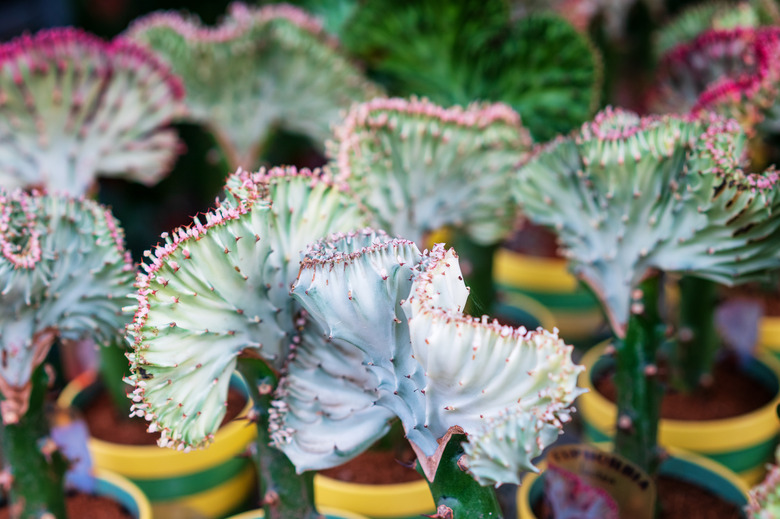How To Care For A Coral Cactus
We may receive a commission on purchases made from links.
The coral cactus (Euphorbia lactea f. cristata), a crested form of mottled spurge (Euphorbia lactea), offers convoluted, fan-shaped green growth marked with silver. Recently, plant sellers have begun to graft coral cactus fans in a variety of colors onto the stems of other succulents or cacti. The resulting plants are called variegated coral cactus (Euphorbia lactea f. cristata variegata).
All these euphorbias are perennials in U.S. Department of Agriculture plant hardiness zones 10 and 11. They are also toxic, and their white sap can inflame the eyes, mucous membranes and skin. Care for a coral cactus by supplying its basic needs, such as the proper nutrients and sun exposure, while avoiding direct contact with the plant's sap.
Outdoor Coral Cactus Care
Outdoor Coral Cactus Care
If you wish to try the original ungrafted green form of coral cactus outdoors, plant it in a sunny or partly sunny position on well-drained soil and mulch it with gravel. Unless your climate is very dry, it's a good idea to place cacti in a raised bed ringed by rocks and filled with a combination of 1 part garden soil and 1 part perlite or decomposed granite.
During spring through autumn, water an outdoor coral cactus about once a week when there is no rain. Don't water it at all during the winter. Since cacti in the ground don't need much fertilizer, fertilize the plant only once in midsummer.
For a liquid chemical fertilizer, such as 10-10-5, combine 1 tablespoon of the solution with 1 gallon of water or use 4 tablespoons of solution per gallon of water for a liquid organic type such as 3-3-3. Mix the fertilizer in a watering can and pour it into the soil around the cactus. Be sure to follow all label recommendations for mixing rates, as these examples may vary among different products.
Indoor Potting of Coral Cactus
Indoor Potting of Coral Cactus
The grafted types of coral cactus are often planted in a pot that has been mulched with glued-down gravel. Although the gravel prevents soil from splashing onto the plant, it also prevents testing the moisture of the soil. If such is the case, try to remove the gravel without harming the cactus.
Use barbecue tongs and/or a strap made from folded newspaper to lift the plant, to protect your hands from its sap and spines. Replant it in a pot with drainage holes, either using cactus potting soil or a mix of 1 part general-purpose potting soil and 1 part sand. You can mulch the soil with fine gravel again, but make that loose gravel, so you can feel beneath it.
Caring for an Indoor Euphorbia
Caring for an Indoor Euphorbia
Place a coral cactus on a warm windowsill where temperatures remain between 60 and 80 degrees Fahrenheit. Although the original green, nongrafted type can take full sun, grafted cultivars should receive sunlight only for several hours in the morning or afternoon, but not during the brightest midday hours.
During spring through summer, water the plant once a week or once every two weeks, whenever its soil feels dry 1 inch down. Reduce watering to once a month during autumn and winter, as cacti can rot during those seasons if kept too wet, and resume weekly or biweekly watering in early spring.
Fertilize your indoor coral cactus once every two weeks during spring and summer with a liquid 10-10-10 plant food at one-quarter strength. That would be about three to four drops of the plant food in 1 quart of water, depending on the specific product you use. Refrain from feeding the plant during autumn and winter.
Managing Cactus Pests
Managing Cactus Pests
If pests, such as fuzzy white mealybugs or bumpy brown scale, appear on your plant, clean them off with a cotton swab dipped in rubbing alcohol. Don't use insecticidal soap, which can be damaging to euphorbias.
